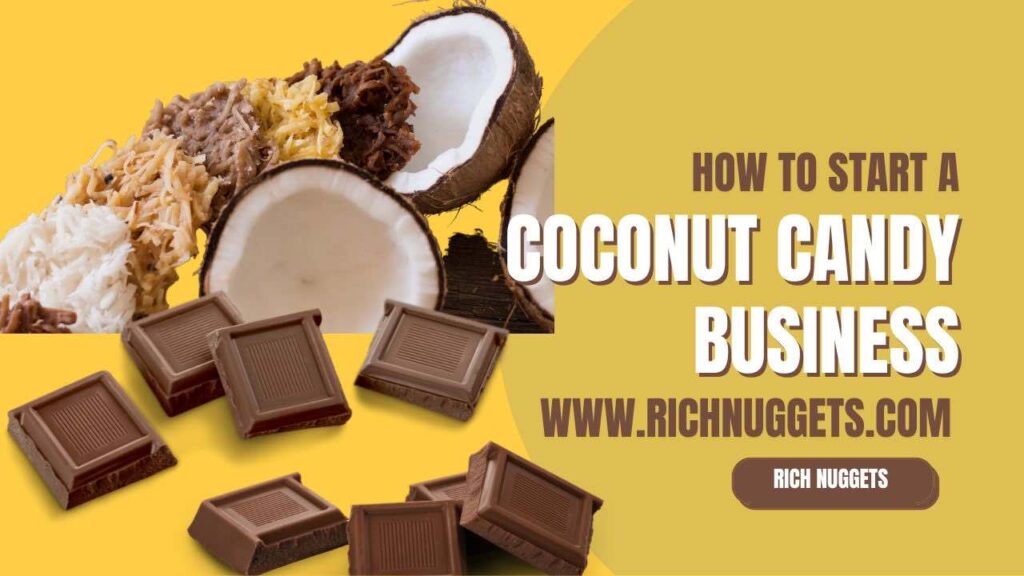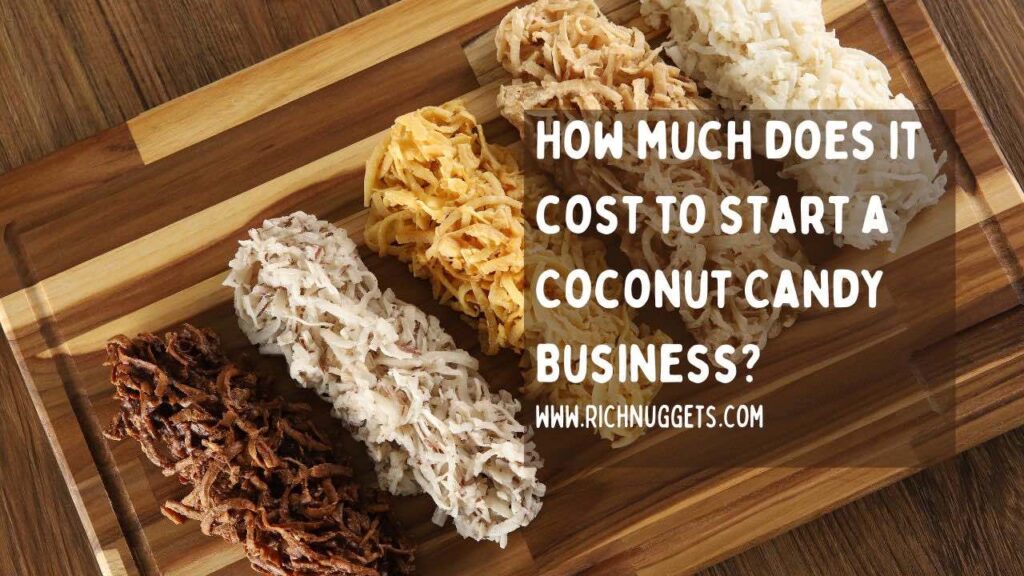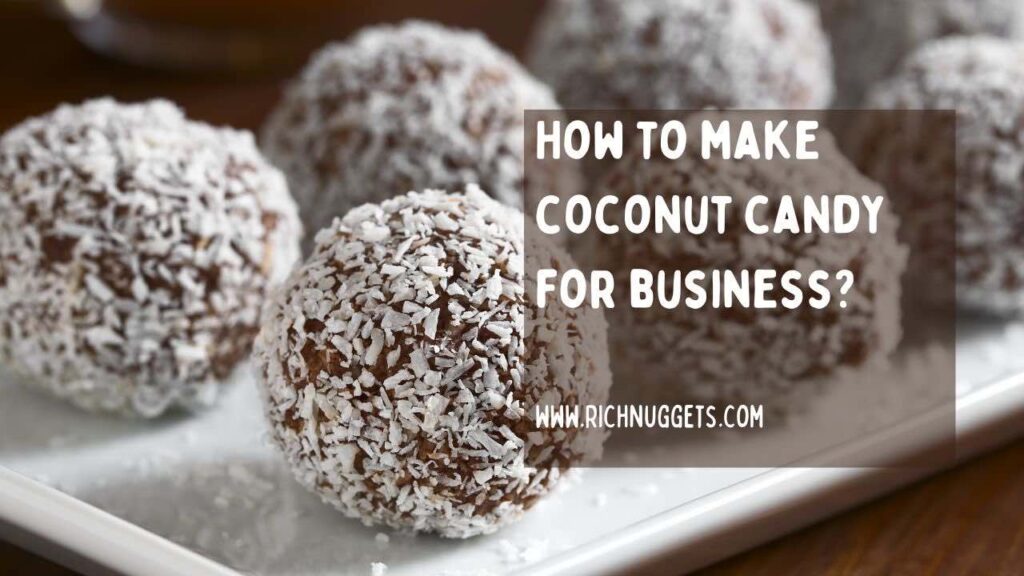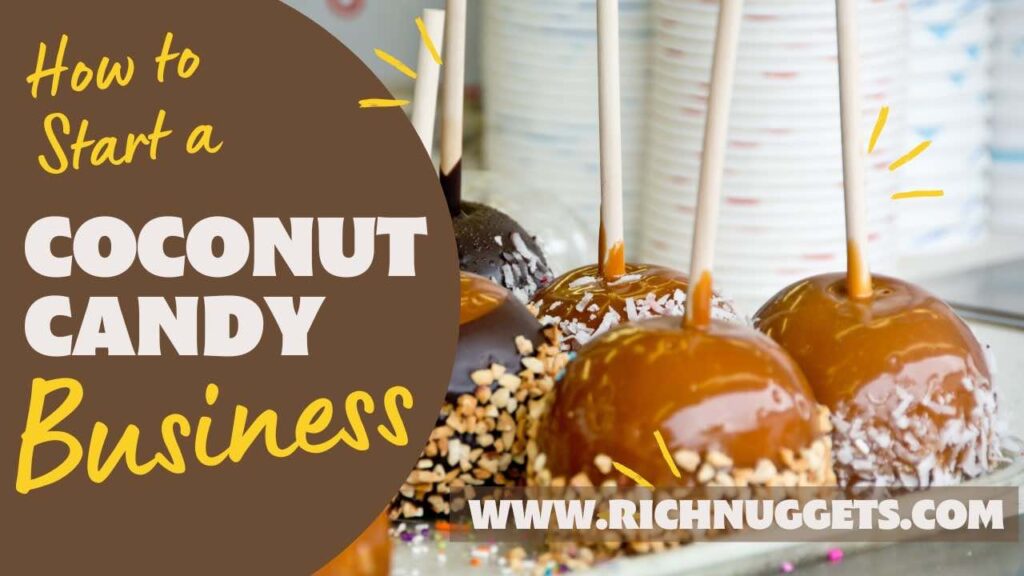
A coconut candy business is a type of enterprise that specializes in producing and selling candies or confectionery products made primarily from coconut as a key ingredient.
Coconut candy is a popular sweet treat in many cultures, especially in tropical regions where coconuts are abundant.
The business revolves around creating a variety of coconut-based candies with different flavors, textures, and forms to cater to the preferences of consumers.
Coconut candy is typically made by combining grated or shredded coconut with ingredients like sugar, condensed milk, and sometimes additional flavorings such as vanilla, chocolate, or fruit extracts.
The mixture is often cooked and then shaped into various forms such as bars, cubes, or bite-sized pieces before being packaged for sale.
Some coconut candies might also incorporate nuts, dried fruits, or other ingredients to enhance the flavor and texture.
Running a coconut candy business involves several key aspects: Recipe development, sourcing ingredients, production, packaging, marketing and sales, distribution, quality control, customer feedback, and scaling
And in this article, we will guide you on how to start a coconut candy business that will be profitable.
Table of Contents
Is coconut candy profitable?
Yes, a coconut candy business is a profitable business that commands high demand, especially from the young demographics. But like any business, success depends on various factors such as the market demand in your target location, product quality, pricing, competition, marketing strategies, and operational efficiency.
There have been testimonials of people making a lot of money from this coconut candy business, and you too can join in that wagon of excitement by engaging in this business.
How much does it cost to start a Coconut Candy Business?

The cost of starting a coconut candy business in Nigeria is majorly influenced by the scale of operation. Starting a microscale coconut candy business in Nigeria requires a minimum investment of 10,000 Naira. However, for small and medium-scale operations, a minimum of 300,000 Naira is necessary.
Operating a coconut candy business at a microscale entails catering to a limited target market, primarily consisting of school children and young individuals within the local vicinity.
On the other hand, managing a coconut candy business at a small and medium scale expands your target market significantly. This includes local markets, grocery stores, supermarkets, online platforms, social media, specialty stores, flea markets, pop-up events, cafes, restaurants, corporate gifting, schools, offices, and hotels.
Effectively serving such a diverse target market as a small and medium scale coconut candy business owner may necessitate hiring additional personnel to alleviate the workload and meet the heightened demand.
How to make coconut candy for business?

First thing first, you have to be familiar with the ingredients. Here are the common ingredients typically used in making coconut candy:
- Coconut: Fresh grated or desiccated coconut is the main ingredient that gives coconut candy its distinct flavor and texture.
- Sugar: Sugar is used to sweeten the candy and create a pleasant taste. Different types of sugar can be used, such as granulated sugar or brown sugar.
- Condensed Milk: Condensed milk adds creaminess and sweetness to the candy. It’s a key ingredient that helps bind the coconut and sugar together.
- Flavorings: Additional flavorings like vanilla extract, coconut extract, or other natural flavorings can enhance the taste of the coconut candy.
- Butter or Oil: Some recipes might include a small amount of butter or coconut oil to enhance the richness of the candy.
- Nuts or Dried Fruits (Optional): Chopped nuts (such as cashews, almonds, or peanuts) or dried fruits (like raisins or dried cranberries) can be added to provide extra texture and flavor.
- Salt: A small amount of salt can balance the sweetness and enhance the overall flavor profile of the candy.
Here’s a simple recipe for basic coconut candy:
Ingredients:
- 2 cups grated coconut
- 1 cup granulated sugar
- 1/2 cup condensed milk
- 1/4 teaspoon vanilla extract
- Pinch of salt
Instructions for making your coconut candy:
- In a non-stick pan, combine the grated coconut, granulated sugar, condensed milk, and salt.
- Cook the mixture over medium heat, stirring constantly to prevent sticking and burning.
- Continue cooking until the mixture thickens and comes away from the sides of the pan (similar to the consistency of cookie dough).
- Remove the pan from the heat and stir in the vanilla extract.
- Transfer the mixture to a greased or lined baking dish and press it evenly.
- Allow the candy to cool and set for a few hours or overnight.
- Once set, cut the candy into desired shapes, such as squares or rectangles.
Feel free to experiment with different variations by adding nuts, dried fruits, or other flavorings to create unique coconut candy flavors that cater to your preferences or the preferences of your target market. And lastly, cooking is an art, try to be creative
How to Start a Coconut Candy Business

Here is how you can start your coconut candy business in Nigeria:
1. Develop your unique Coconut Candy Products
The initial step doesn’t involve diving into market research as you might have thought. Instead, it’s all about deciding the specific kind of coconut candy you intend to offer for sale.
When you approach supermarkets, hotels, local grocery stores, and other avenues to reach your customers, you’ll need to persuade them about why they should buy from your candy business or give your candies a spot on their shelves.
But here’s the thing: if your coconut candy is just like the regular ones, they might not be too keen on welcoming another competitor without any uniqueness.
This is because there’s a good chance that someone might have been partnering with them before you came along. This is quite likely, considering the strong demand for coconut candies and the high supply that accompanies it.
In developing your unique coconut candy you have these two steps;
a). Sourcing Ingredients:
This implies finding a reliable supplier who can give you high-quality, steady, and reliable ingredients.
These would include fresh coconuts, sugar, flavorings (like vanilla or other extracts), and any other elements needed for your coconut candy recipes.
The aim of sourcing these ingredients through a reliable supplier or suppliers is to make sure you always have a steady and reliable supply of high-quality materials for making your unique coconut candies.
Forming solid bonds with suppliers and keeping communication open is crucial to ensure a seamless production process.
b). Recipe Development:
Before you dive into creating and perfecting your own recipes, your starting point should be getting the hang of the basic and widely-used recipe mentioned earlier in this article.
It’s all about tweaking the foundational recipe to achieve the distinct flavor, texture, and appearance that will set your coconut candy apart from the numerous others on the market.
Don’t hesitate to play around with different variations until you land on the outcome you’re aiming for.
c). Feedback
Once you’ve got your recipe down, the next step is to put your products to the test with a diverse group of people such as family and friends. This way, you can gather feedback and pinpoint areas for improvement before finalizing your unique coconut candy.
This process demands creativity, meticulous attention to detail, and a readiness to adapt based on feedback and what the market prefers.
2. Market Research and Business Plan
Market research follow by a comprehensive business plan is the next step to take. In market research, your focal point is on gathering and analyzing information about the potential market for your product.
The information you are able to gather and perfectly analyze is what you will use to develop a marketing strategy that will help your business penetrate the market.
When it comes to market research, you’re putting the spotlight on a few main things: Target audience, consumer behavior, popular flavors, pricing trends, competition analysis, and gaps and opportunities.
Once you’re done with your research, it’s time to put together your business plan.
Think of your business plan as a document that covers every nook and cranny of your business. This ranges from your business goals and strategies to its financial projections.
The main purpose of creating a business plan after your market research is to document your research findings and use it as a road map to guide your business through the path of success in the candy industry.
Apart from your market research data gathering other key elements should also be contain in your business plan such as; Business goals and objectives, product description and processes, sales and distribution, operational plan, risks and mitigation strategies, and swot analysis.
3. Legal Requirements
Legal requirements are like the rulebook that tells you exactly what you need to do to make sure your business is playing by the legal rules. These steps make sure your business is a legitimate entity and follows all the right regulations. And they are;
1. Business Registration: If you’re just doing a microscale coconut candy business, you might not have to officially register your business. But if you’re going a bit bigger, like small or medium scale, then business registration is a must-do. This is like giving your business a legal ID card. You get recognized by the law, and it also tells everyone what kind of business you are (like a one-person show or a partnership). The big boss of business registration in Nigeria is the Corporate Affairs Commission (CAC).
2. Permits and Licenses: The major permit and license is the National Agency for Food and Drug Administration and Control (NAFDAC) number. Once you get this number, you’re good to go with selling your coconut candy to the public without worrying about your products getting rejected. And remember, along with having great and healthy products, another thing that could speed up your NAFDAC certification is making sure you follow Food Safety Compliance. This means you’re following all the cleanliness and hygiene rules, from how you handle your ingredients to keeping your workspace squeaky clean.
3. Tax Identification: This is like getting your own special tax code. It’s called a Tax Identification Number (TIN), and you can get it from the tax authorities (either the federal or state internal revenue service). This little number is super important because it keeps you in the clear with taxes.
4. Intellectual Property Protection: If you’ve come up with a cool brand name, logo, or anything else that’s unique, you might want to protect it. Registering trademarks or copyrights makes sure no one else can steal your unique creativity.
Doing all these legal requirements sets you up to avoid any legal drama down the road. Plus, be prepared for periodic inspections by relevant authorities to ensure that your business operations are compliant with legal standards.
4. Production Setup
When we talk about “production setup” in the context of starting a coconut candy business, we’re referring to the process of creating a functional and efficient space where you’ll be making your coconut candies.
This involves setting up a dedicated commercial kitchen equipped with all the necessary tools and equipment required for candy production. In addition to the efficient arrangement of the kitchen space, it should adhere to strict hygiene standards.
The must required tools and equipment for your candy production are;
- Mixers: For mixing ingredients thoroughly.
- Cooking Equipment: Such as stovetops, ovens, and cookers for preparing the candy mixture.
- Utensils: Spoons, spatulas, molds, measuring tools, and other utensils required for various stages of production.
- Packaging Equipment: Tools for packaging the candies, such as sealing machines or wrapping materials.
- Refrigeration: To store perishable ingredients and finished products.
- Storage Shelves: For organizing ingredients, packaging materials, and tools.
- Cleaning Supplies: Cleaning products and equipment to maintain hygiene in the kitchen.
Proper planning and attention to detail in this setup phase contribute to the smooth and safe operation of your coconut candy business.
5. Packaging and Branding
This section refers to designing and packaging your coconut cady, not to only look appealing but to also communicate your brand identity and keep your coconut candies fresh and protected (very important).
The design should be memorable, visually attractive, and aligned with your business’s unique selling points.
The goal of a well-designed package and branded coconut candy is to increase the overall customer experience which has a direct impact on the success of your coconut candy business
6. Determine Your Sales and Distribution Channel
You have to determine the sales and distribution channel that will be best suited to incorporate into your coconut candy business. Selecting the right sales and distribution channels is important for reaching your target audience effectively. And here are some effective sales and distribution channels to consider;
- Local Markets
- Supermarkets and Grocery Stores
- Online Platforms
- Specialty Stores
- Cafes and Restaurants
- Flea Markets and Pop-Up Events
- Corporate Gifting
- Schools and Offices
- Hotel Gift Shops
- Local Events and Festivals
- Delivery Services
- Direct Sales
Selecting the right sales and distribution channels depends on your target audience, business strategy, budget, and resources. It’s often beneficial to diversify your sales channels to reach a broader range of customers and maximize your product’s visibility and accessibility.
7. Marketing and Promotion
Without a great effort in marketing and promoting your candy business, you will find it difficult to penetrate the market. It is all about making people aware of your brand and products, and encouraging them to buy from you.
Here is how you can effectively market and promote your candy business;
- Quality: You must be bent on making high-quality coconut candies. Yes, it might mean you selling for a higher price, but it is better people know your coconut candy to be costly but of high-quality than to be cheap and of low quality.
- Use Social Media: Social media is like a big online place where people share things. You can use it to show pictures of your candies, tell stories about them, and let people know where to buy them.
- Local Advertisements: You can put up posters or ads in your local area to tell people about your candies. It’s like saying, “Hey, we have yummy coconut candies here!”
- Sampling Marketing: Imagine giving out small pieces of your candies for people to taste. This is like letting them try a little bit to see how much they like it. When they like it, they might want to buy more. This is commonly seen within our marketplaces where a stage is set with music and a limited amount of the products are either given to be tried out for free or someone among the marketers is testing the products for the public to see (especially detergent products).
- Sales Channel: Creating awareness of your products through sales channels is another effective way to market and promote your coconut candy business. This sales channel encompasses schools and Offices, Hotel gift shops, flea markets and pop-up events, supermarkets and grocery stores, local markets, local events and festivals, and direct sales,
In short, marketing and promotion are about telling people about your coconut candies, showing them how great they are, and making them excited to buy and enjoy them.
Challenges in Starting a Coconut Candy Business
Operating a coconut candy business in Nigeria may encounter several challenges, such as:
- Raw Material Availability: Sourcing an adequate and consistent supply of quality coconut can be a challenge. The availability of coconuts may vary seasonally, impacting production stability.
- Infrastructure and Transportation: Poor transportation infrastructure leads to difficulties in moving raw materials from farms to processing facilities and finished products to market. This can result in delays and increased costs.
- Processing Equipment and Technology: Access to modern and efficient processing equipment for coconut candy production may be limited. Outdated technology can affect the quality and quantity of the final product.
- Quality Control: Maintaining consistent quality in coconut candy production can be challenging due to variations in coconut quality, processing methods, and storage conditions.
- Market Competition: The coconut candy market is competitive, with established brands dominating shelf space. New entrants may face challenges in building brand recognition and gaining consumer trust.
- Packaging and Shelf Life: Ensuring proper packaging that preserves the freshness and extends the shelf life of coconut candies is crucial. Inadequate packaging can lead to product spoilage and customer dissatisfaction.
- Regulatory Compliance: Adhering to regulatory standards and obtaining necessary certifications can be complex. Compliance with food safety regulations is crucial for consumer trust and market access.
- Consumer Preferences: Understanding and adapting to the diverse preferences of the Nigerian consumer market can be challenging. Consumer tastes may vary across regions, and staying attuned to trends is essential for product success.
- Economic Factors: Economic fluctuations, inflation, and currency instability can impact production costs, pricing strategies, and overall business sustainability.
- Marketing and Distribution: Effectively marketing coconut candies and establishing a reliable distribution network can be challenging. Building a brand presence and ensuring products reach the target market efficiently require strategic planning.
READ ALSO:
- How to Start a Bakery Business in Nigeria (The Super Easy Way)
- 16 Lucrative Staple Food Business Ideas in Nigeria
- How to Start a Food Business in Nigeria
- How to Start Palm Oil Business in Nigeria
Final Thoughts on Starting a Coconut Candy Business in Nigeria
In conclusion, embarking on the journey to start a successful coconut candy business in Nigeria involves a well-thought-out series of steps such as; crafting your distinctive coconut candy products, delving into market research and business planning, tending to the legal obligations, establishing the production framework, refining packaging and branding, pinpointing your sales and distribution avenue, and immersing yourself in marketing and promotional efforts. In addition, this business requires creativity, diligence, and strategic planning.
Remember to subscribe via Email or by turning on the Bell 🔔 Notification to get updated directly on your device when new articles are published
Discover more from StartBizEasy
Subscribe to get the latest posts to your email.





